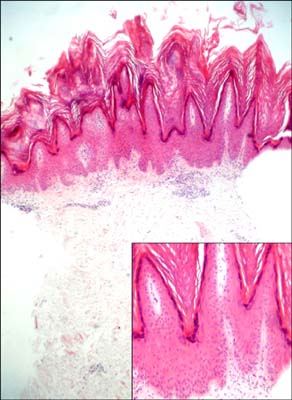Ann Dermatol.
2011 Sep;23(Suppl 1):S61-S63. 10.5021/ad.2011.23.S1.S61.
Non-familial Acrokeratosis Verruciformis of Hopf
- Affiliations
-
- 1Department of Dermatology, The Catholic University of Korea School of Medicine, Seoul, Korea. jylee@catholic.ac.kr
- KMID: 2156753
- DOI: http://doi.org/10.5021/ad.2011.23.S1.S61
Abstract
- Acrokeratosis verruciformis of Hopf is a rare genodermatosis with an autosomal dominant mode of inheritance. It is a disorder of keratinization, characterized by multiple, flat-topped, skin-colored keratotic lesions resembling plane warts typically observed on the dorsum of the hands and feet. Histopathologically, the lesion shows considerable hyperkeratosis, acanthosis, and papillomatosis, mimicking a "church spire", and a thickened granular layer. It arises in early life, often at birth or infancy. Herein, we report on a rare sporadic case of acrokeratosis verruciformis of Hopf. A 44-year-old Caucasian man presented with multiple, grouped, hyperkeratotic, whitish, flat papules on his shins and feet, which had been present for more than one year. Histopathological examination showed typical findings of acrokeratosis verruciformis of Hopf. Our case is unique in that the patient had no familial history of similar skin lesions.
Figure
Reference
-
1. Hopf G. Über eine bisher nicht beschriebene disseminierte. Keratose (Akrokeratosis verruciformis). Dermatologische Zeitschrift. 1931. 60:227–250.
Article2. Dhitavat J, Macfarlane S, Dode L, Leslie N, Sakuntabhai A, MacSween R, et al. Acrokeratosis verruciformis of Hopf is caused by mutation in ATP2A2: evidence that it is allelic to Darier's disease. J Invest Dermatol. 2003. 120:229–232.
Article3. Alain H. Wolff K, Goldsmith LA, Katz SI, Glichrest BA, Paller AS, Leffell DJ, editors. Acantholytic disorders of the skin: Darier-White disease, acrokeratosis verruciformis, Grover disease, and Hailey-hailey disease. Fitzpatrick's dermatology in general medicine. 2006. 7th ed. New York: McGraw-Hill;437.4. Niedleman ML, McKusick VA. Acrokeratosis verruciformis (Hopf). A follow-up study. Arch Dermatol. 1962. 86:779–782.5. Herndon JH, Wilson JD. Acrokeratosis verruciformis (Hopf)and Darier's disease. Genetic evidence for a unitary origin. Arch Dermatol. 1966. 93:305–310.
Article6. Schueller WA. Acrokeratosis verruciformis of Hopf. Arch Dermatol. 1972. 106:81–83.
Article7. Berk DR, Taube JM, Bruckner AL, Lane AT. A sporadic patient with acrokeratosis verruciformis of Hopf and a novel ATP2A2 mutation. Br J Dermatol. 2010. 163:653–654.
Article8. Farro P, Zalaudek I, Ferrara G, Fulgione E, Cicale L, Petrillo G, et al. Unusual association between acrokeratosis verruciformis of Hopf and multiple keratoacanthomas. Successful therapy with acitretin. J Dtsch Dermatol Ges. 2004. 2:440–442.9. Serarslan G, Balci DD, Homan S. Acitretin treatment in acrokeratosis verruciformis of Hopf. J Dermatolog Treat. 2007. 18:123–125.
Article10. Kaliyadan F, Manoj J, Venkitakrishnan S. Acrokeratosis verruciformis of hopf associated with dilated cardiomyopathy. Indian J Dermatol. 2009. 54:296–297.
Article11. Wang PG, Gao M, Lin GS, Yang S, Lin D, Liang YH, et al. Genetic heterogeneity in acrokeratosis verruciformis of Hopf. Clin Exp Dermatol. 2006. 31:558–563.
Article12. Panja RK. Acrokeratosis verruciformis: (Hopf)-A clinical entity? Br J Dermatol. 1977. 96:643–652.
Article
- Full Text Links
- Actions
-
Cited
- CITED
-
- Close
- Share
- Similar articles
-
- Acrokeratosis Verruciformis of Hopf: Report of a Case
- A Case of Acrokeratosis Verruciformis of Hopf
- Coexistence of Darier's Disease and Acrokeratosis Verruciformis of Hopf
- A Case of Acrokeratosis Verruciformis of Hopf
- A Case of Darier's Disease Associated with Guttate Leukoderma and Acrokeratosis Verruciformis



